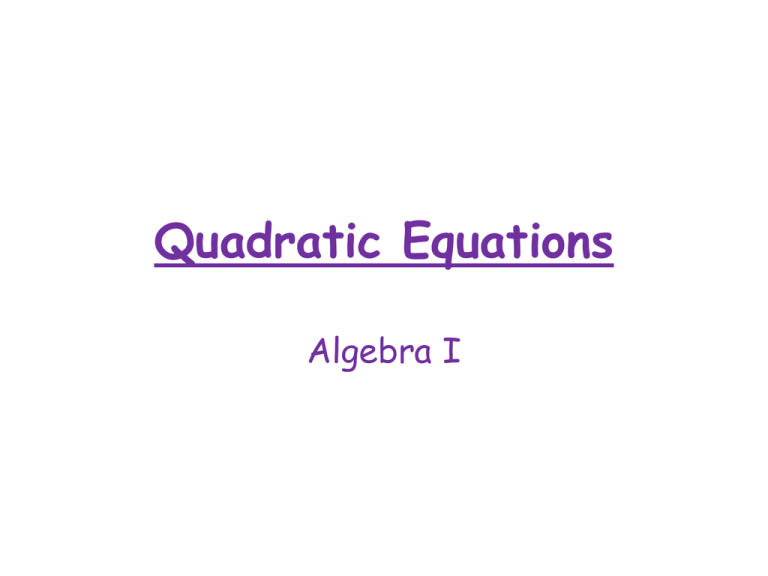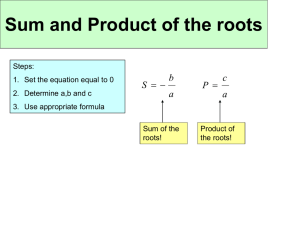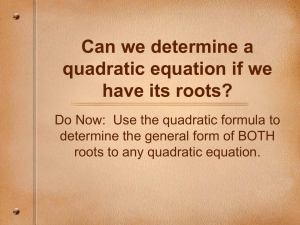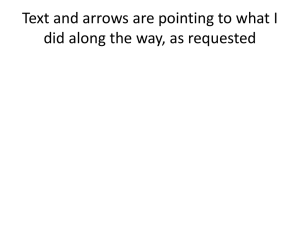Quadratic Equations
advertisement

Quadratic Equations
Algebra I
Vocabulary
• Quadratic Function (equation) – A
function describing the height of a
rocket.
• Standard Form y = ax²+ bx + c, a ≠ 0
• Parabola – The graph of a quadratic
function.
Vocabulary
• Solutions – Called roots, zeros or x
intercepts. The point(s) where the
parabola crosses the x axis.
• Minimum – The lowest point of the
parabola on the y axis (on the calculator,
when the y value is the lowest).
• Maximum – The highest point of the
parabola on the y axis (on the calculator,
when the y value is the highest).
Vocabulary
• Number of roots – Can have one, two or
no roots.
• Vertex – The minimum or maximum
point.
• Positive Parabola – Going up.
• Negative Parabola – Going down.
Vocabulary
• Axis of Symmetry – Directly down the
middle of the parabola. The only point
in the middle of the parabola is the
vertex. Each point on the parabola that
is on one side of the axis of symmetry
has a corresponding point on the other
side of the axis of symmetry.
Axis of Symmetry
• Axis of symmetry equation – finding the x
value.
Ex)
x=
y = -3x² – 6x + 4
a = -3
b = -6
c=4
Axis of Symmetry
• Axis of symmetry equation – finding the
x value.
Ex)
y = -3x² – 6x + 4
a = -3
x = -(-6)/2(-3)
b = -6
x = -1
c=4
Axis of Symmetry
• Find the y value by substituting the x
value into the equation and solve for y.
Ex)
y = -3x² – 6x + 4
x = -1
y = -3(-1)²- 6(-1) + 4
y=7
Vertex (-1, 7)
Axis of Symmetry
• Calculator
– Enter the equation into the y= function on the
calculator
– Look at the graph to determine a positive or
negative parabola
– Go to 2nd graph to see the table
• Scroll up and down to find where the y values start
to repeat, there will be one point that doesn’t
repeat, this is the vertex.
• The number in the x column is the x value and the
corresponding number in the y column is the y value.
Example
y = x²- x - 6
Example
y = x²- x – 6 (not found in calculator)
a=1
x = -(-1)/2(1)
b = -1
x=½
c = -6
y = (½)²- ½ - 6
y = -6¼
Vertex (½, -6¼)
Now you try…
y = 2x²- 4x – 5
y = -x²+ 4x - 1
Now you try…
y = 2x²- 4x – 5
(1,-7) minimum
y = -x²+ 4x – 1
(2,3) maximum
Roots
• Can solve by factoring
x²+ 6x – 7 = 0
Roots
• Can solve by factoring
x²+ 6x – 7 = 0
(x + 7)(x – 1) = 0
Roots
• Can solve by factoring
x²+ 6x – 7 = 0
(x + 7)(x – 1) = 0
Now set each factor =0
Roots
• Can solve by factoring
x²+ 6x – 7 = 0
(x + 7)(x – 1) = 0
x+7=0
x–1=0
x = -7
x=1
*** Two roots (sometimes called a double
root)
Roots
b²+ 4b = -4 (re write =0)
b²+ 4b + 4 = 0
Roots
b²+ 4b = -4 (re write =0)
b²+ 4b + 4 = 0
Now factor
Roots
b²+ 4b = -4 (re write =0)
b²+ 4b + 4 = 0
Now factor
(b + 2)(b + 2) = 0
b+2=0
b = -2
***This is a single root, only one answer.
Roots
• Roots can often times be found on the
calculator
– Enter the equation in the y=
– Graph, this will show you how many roots
– Go to the table
– Find where the y value is zero
Roots
x²- x + 4 = 0
Roots
x²- x + 4 = 0
Prime, can’t factor
No x intercept – no roots (see this when
you graph) – always check the graph, some
are prime, but still cross the x axis.
Roots
n²+ 6n + 7 = 0
• Prime – can’t factor, but it does cross
the x axis.
• Sometimes we estimate the roots.
• One root is between -5 and -4, the
other root is between -2 and -1.
• These are rational roots.
Roots
• When you can’t factor the equation, use
the quadratic formula:
𝑥=
−𝑏± 𝑏2 −4𝑎𝑐
2𝑎
*** This is on your formula sheet for
testing.
Roots
• Use the Quadratic Formula:
24x²- 14x = 6 (re write)
24x²- 14x – 6 = 0
a = 24, b = -14, c = -6
−𝑏 ± 𝑏2 − 4𝑎𝑐
𝑥=
2𝑎
*** This is on your formula sheet for
testing.
Roots
• Use the Quadratic Formula:
24x²- 14x – 6 = 0
a = 24, b = -14, c = -6
−(−14) ± (−14)2 −4(24)(−6)
𝑥=
2(24)
Solve
Roots
• Use the Quadratic Formula:
24x²- 14x – 6 = 0
14 ± 772
𝑥=
48
Roots
• Use the Quadratic Formula:
24x²- 14x – 6 = 0
14 ± 772
𝑥=
48
Now separate into two problems. One is
+, the other is -
Roots
• Use the Quadratic Formula:
24x²- 14x – 6 = 0
14 − 772
𝑥=
48
Solve both problems
Roots
• Use the Quadratic Formula:
24x²- 14x – 6 = 0
14 − 772
𝑥=
48
x ≈ -0.3
x ≈ 0.9
**** The symbol ≈ means approximate value.
Now you try…
x²- 2x – 24 = 0
3x²+ 5x + 11 = 0
Now you try…
x²- 2x – 24 = 0
{-4,6} This is a solution set, NOT an
ordered pair. These are the numbers
where the parabola crosses the x axis.
3x²+ 5x + 11 = 0
No roots – no solution
Discriminant
• To find the discriminant use part of the
quadratic formula.
b²- 4ac
Discriminant
• If the discriminant is < 0, there are no
roots.
• If the discriminant is > 0, there are two
roots.
• If the discriminant is = 0, there is one
root.







